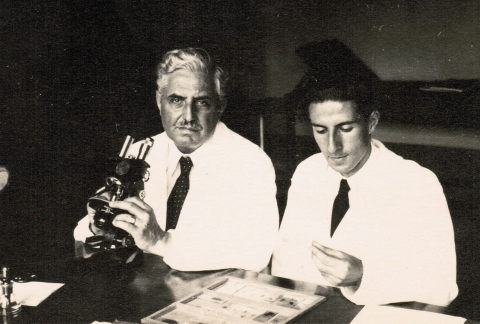Psychosis
Revisiting Silvano Arieti on Schizophrenia
An overview of his contributions to theory and practice.
Posted April 4, 2021 Reviewed by Jessica Schrader
Key points
- Silvano Arieti was considered one of the world's foremost experts on schizophrenia.
- A psychoanalyst, Arieti adopted a psychological (and biopsychosocial) approach to the disorder.
- His psychotherapeutic method emphasized basic trust, warmth, and closeness, along with the interpretation of symptoms.
- His contributions to the theory and treatment of schizophrenia remain relevant today.
Few have made as important contributions to the understanding of schizophrenia as the late Italian American psychiatrist Silvano Arieti. Given the more recent focus on genetic and biological studies of schizophrenia, it is pertinent to review a predominantly psychological (and biopsychosocial) approach to the disease. I have written elsewhere on Arieti and his life's work (see Ruffalo, 2018, 2019), but here I wish to provide a brief, general overview of his major contributions to the theory and psychotherapy of schizophrenia.
Schizophrenia From a Psychological Perspective
Unlike most psychiatrists of his generation, who became more interested in the use of phenothiazines and biological remedies for schizophrenia than in talking therapies, Arieti maintained throughout his career chief interest in the psychotherapeutic method with schizophrenia patients. Arieti (1978) notes that his interest in this area developed during his residency training at Pilgrim State Hospital—at the time, the largest psychiatric hospital in the world—from 1941 to 1946, when he realized that the most hopeless patients held in the hospital's back wards improved significantly in response to the development of an attachment with a nurse or caregiver. Some of these patients became well enough to be discharged.
Recalling this experience, Arieti (1978) wrote:
I was impressed by the fact that even an advanced schizophrenic process had proved to be reversible or capable of being favorably influenced by a human contact. These were quite unusual notions at the time. I thought that perhaps methods could be devised by which I could help the patient maintain, increase, strengthen the achieved amelioration, even outside of the hospital environment. But of course I had no idea of how to do it. I had nevertheless learned that whatever benefit the patient could receive, had to come from his bonds with at least another human being.

For the next 30 years, Arieti devoted himself to the psychological study of the problem of schizophrenia, culminating in his 1974 book Interpretation of Schizophrenia, which was awarded the National Book Award in the Science category.
Despite his emphasis on the psychological factors involved in schizophrenia, Arieti endorsed research into the biological and genetic contributions to the illness, devoting four chapters to biology in Interpretation of Schizophrenia, including "The Biochemistry of Schizophrenia" and "The Central Nervous System in Schizophrenia" (Arieti, 1974a). As Pies (2017) notes, Arieti's writing is an early example of a biopsychosocial approach to mental disorder, a subject upon which I based my 2019 paper incorporating Arieti's perspective, "Understanding Schizophrenia: Toward a Unified Biological and Psychodynamic Approach."
Summarizing his views on the matter, Arieti (1978) wrote:
I believe that, whenever possible, an attempt should be made to integrate the biological with the psychological … Although I am convinced that every function (or dysfunction) of the brain is mediated by a biochemical change, I have always found myself drawn more toward inquiries into the psychological factors which bring about suffering or dysfunction, or are powerful enough to change what is only a biological predisposition into a clinical actualization.
The Psychodynamics of the Early Environment
Arieti (1974b) believed that the early environment of the patient was almost always saturated with anxiety, and that the child who would go on to develop schizophrenia was often raised in an environment that was "not able to offer him a modicum of security or basic trust." Later in his career, Arieti challenged the prevailing psychoanalytic belief that the personality and attitude of the mother is the most important psychogenic factor, insisting that intrapsychic processes—those occurring within the patient—lead to a "transformation of the parental image" in which the mother (or father) is seen as being much worse than in reality.
On this subject Arieti (1974b) writes, "The patient who responds mainly to the negative parts of his mother will try to make a whole out of these negative parts, and the resulting whole will be a monstrous transformation of the mother." Stressing these intrapsychic agencies, Arieti maintained that the patient is not a tabula rasa, or a sponge which soaks up whatever is given him, but that he adds "an element of his own individuality and creativity to what he receives and thus [contributes] to his own [psychotic] transformation" (Arieti, 1974b).
Thus, Arieti must be distinguished from the other psychoanalytic theorists of his day, such as Theodore Lidz and Gregory Bateson, who placed significant blame on the family, and in particular on the mother, for the patient's schizophrenia. In contrast, Arieti contended that both environmental and intrapsychic factors—as well as biological and genetic ones—weighed in the development of this major psychosis.

The Prepsychotic Period and Psychotic Regression
Arieti (1974a) traces the psychodynamic development of schizophrenia from birth through four stages. In the first period, occurring in early childhood, the future patient has a difficult time accepting the "Thou," the other person, who is needed to form the patient's "I" or self. The Thou is perceived as the malevolent Thou and the I as bad me. During the second period (later childhood), the Thou is transformed into a distressing other and the bad me into a weak, inadequate me. Arieti (1974b) writes that during this period, the child comes to "see himself as a weakling in a world of strong and distressing adults."
Arieti's third period, starting roughly at puberty, is characterized by the child's inability to sustain a self-esteem and a sense of personal significance upon entering the larger social world. Arieti (1974b) writes, the patient "does not feel prepared for what he experiences as perennial challenge… The patient comes to believe that the future has no hope, the promise of life will not be fulfilled. He feels unaccepted and unacceptable, unfit, alone."
At this point, the patient has only one solution, one defense, that remains: "to dissolve or alter his cognitive functions [and] the thought processes that have brought about conceptual disaster…" (Arieti, 1974b). The break with reality occurs; this represents Arieti's fourth period.
The Four Stages of Schizophrenia
In addition to the four periods of the psychodynamic development of schizophrenia, Arieti (1974a, 1974b) also describes four stages of the illness itself: the initial, advanced, preterminal, and terminal stages. In the initial stage, anxiety is heightened and a sense of equilibrium is lacking. In this stage, the patient progresses through three phases, including a phase of panic ("strange things are happening"); a phase of psychotic insight (in which he succeeds at "putting things together" and "making sense" of his new reality); and a phase of multiplication of symptoms (in which symptoms become more and more intense and frequent).
In the second, or advanced, stage, the patient has come, more or less, to accept the illness. The psychotic symptoms remain, but they do not seem to bother the patient as much as before. Life has become increasingly restricted and lacks spontaneity. The patient's behavior becomes routine and stereotyped.
In the next stage, the preterminal stage, the patient's symptoms have burned out, and the different types of schizophrenia (e.g., paranoid, hebephrenic, catatonic) come to closely resemble each other. Primitive and odd behavior prevail. In the natural, untreated course of the disorder, this stage typically occurs between five and fifteen years after the initial episode.
And in the fourth or terminal stage, the patient's behavior becomes even more primitive and reflex-like. He may grab for food and, later, ingest inedible objects. Perceptual alterations may appear, such as insensitivity to pain, temperature, or taste.
Due to advances in the treatment of schizophrenia, patients in the latter stages of the disease are becoming less common. While these terminal and preterminal cases filled the back wards of state hospitals decades ago, most patients who present for treatment today are in the first (or, less commonly, second) stage of schizophrenia. Arieti contended that while psychotherapy may be helpful for patients in the first two stages of the disease, it does not offer any such relief for patients in the latter two stages.
Concretization and Metaphor in Schizophrenia
Arieti maintained that the symptoms of schizophrenia reflect a psychological process known as concretization, wherein abstract beliefs are transformed into definite, concrete representations or forms. Thus, hallucinations and delusions, for instance, are not random, meaningless phenomena but rather understandable and interpretable communications. Nevertheless, Arieti stressed that these concretizations become very real to the patient in their perception of the world.

Describing this process, Arieti (1960) writes, "If a patient makes the statement that he smells a bad odor emanating from his body, his language is metaphoric and symbolic for us, because we interpret, rightly so, that the patient feels that he is a rotten person, that he stinks in a metaphoric sense." He continues, "The fact, however, is that the patient has an olfactory hallucination and he really smells a bad odor. What appears to us as a metaphoric expression is only a regressive phenomenon based on a concretization of perceptualization of an anxiety-laden concept about himself" (Arieti, 1960).
Paranoid delusions are interpreted similarly by Arieti (1974b), who writes, "In the paranoid type of schizophrenia, the patient projects to the external world the evaluation of self that he had previously accepted. No longer will he accuse himself. The accusation now comes from the external world." Arieti called catatonia a "disorder of will," observing that the afflicted patient is "tortured by the potential destructiveness of responsibility [and] the passivity of the catatonic is a relief from such responsibility" (Arieti, 1961).
The Psychotherapy of Schizophrenia
In the second edition of Interpretation of Schizophrenia, Arieti illustrates, in great detail, his psychotherapeutic technique in working with schizophrenia patients. It aims, in part, at "reestablishing the bond of human relatedness with the patient, attacking psychotic symptoms with specific techniques, understanding the psychodynamic history, especially the misinterpreted relations with the family, and helping the patient to unfold toward new, nonpsychotic patterns of living" (Arieti, 1974b).
In the early stages of treatment, the establishment of basic trust is of paramount importance; the patient must come to feel that, despite his unusual experiences, he is no longer alone in the world. Of equal importance is the therapist's warmth, closeness, and support. Interpretation is not very important in the acute phases of the illness, but it can be helpful in latter stages of treatment, for instance, teaching the patient how he concretizes his feelings and ideas. Arieti describes his approach as being "as nourishing as it is interpretive" (Arieti, 1974b).
While the therapist assumes a parental role early in treatment, he "gradually becomes a peer of the patient," (Arieti, 1974b) promoting the patient's autonomy, individuality, and self-assertion. With intensive and prolonged psychotherapy, the patient can achieve not only amelioration of symptoms but also levels of integration and life satisfaction that exceed those present before he became psychotic.
References
Arieti, S. (1960). Recent conceptions and misconceptions of schizophrenia. American Journal of Psychotherapy, 14, 3–29.
Arieti, S. (1961). Volition and value: A study based on catatonic schizophrenia. Comprehensive Psychiatry, 2(2), 74-82.
Arieti, S. (1974a). Interpretation of schizophrenia (2nd ed.). Basic Books.
Arieti, (1974b). An overview of schizophrenia from a predominantly psychological approach. American Journal of Psychiatry, 131(3), 241-249.
Arieti, S. (1978). On schizophrenia, phobias, depression, psychotherapy, and the farther shores of psychiatry. Brunner/Mazel.
Pies, R. W. (2017, September 4). Hearing voices and psychiatry's (real) medical model. Psychiatric Times. https://www.psychiatrictimes.com/view/hearing-voices-and-psychiatrys-re…
Ruffalo, M. L. (2018, August 1). The wisdom of Silvano Arieti, pioneer in schizophrenia. Psychology Today. https://www.psychologytoday.com/us/blog/freud-fluoxetine/201808/the-wis…
Ruffalo, M. L. (2019). Understanding schizophrenia: Toward a unified biological and psychodynamic approach. Psychoanalytic Social Work, 26(2), 185-200. doi:10.1080/15228878.2019.1616570




